

era
in L EADERSHI P
Proj ec t Man agement

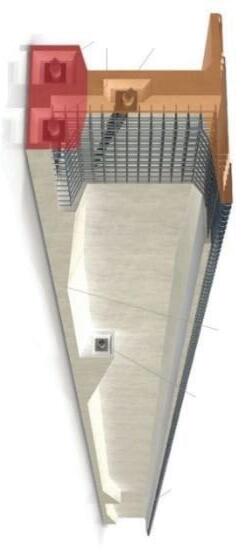

The BH Girder is an innovati ve and enhan ce d ve rsion of pr es tressed concrete Girder that utilizes the Bulb-T shape integrated with Half Slab which enables it to be applied o ve r a span of longer than 60m. By adopting the lat es t cutting-edge technologies and innovation, the BH Girder has been designed to ac hie ve the ultimate goals of Cost Effecti ve ne ss , Rapid Construction, A es thetics and Safety.

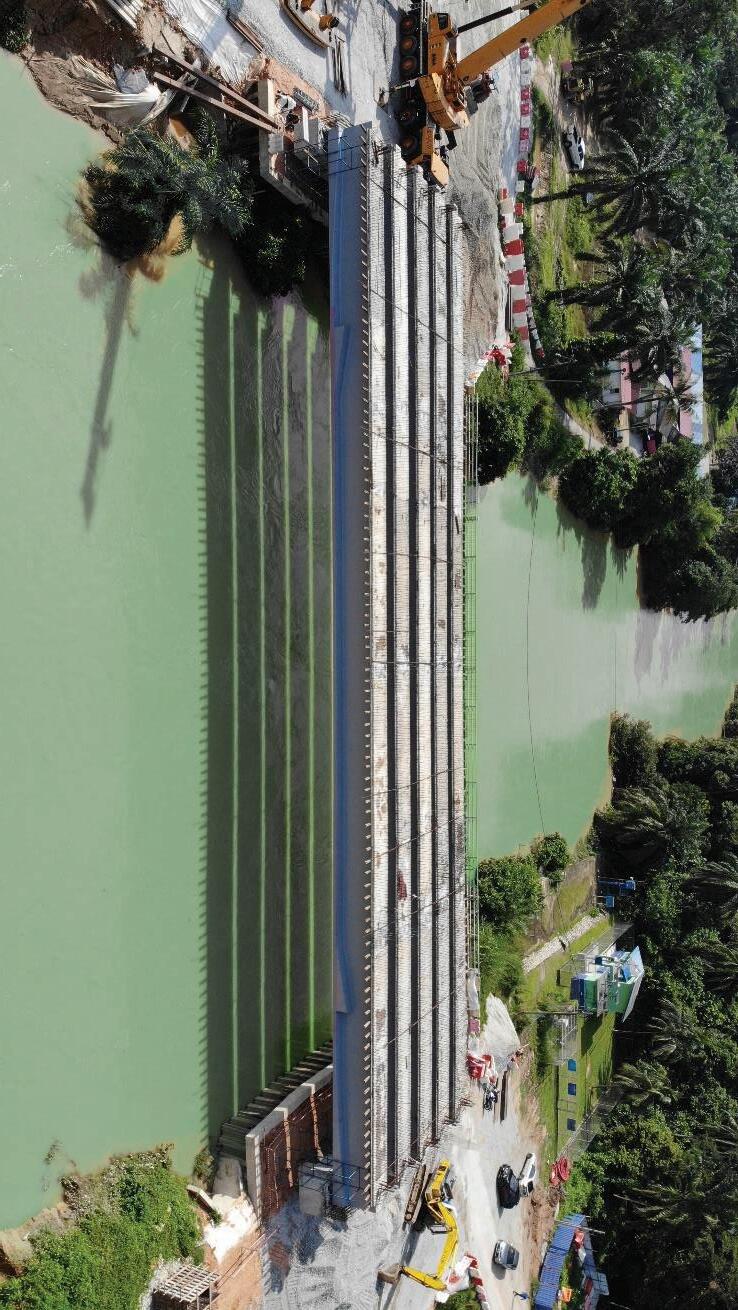
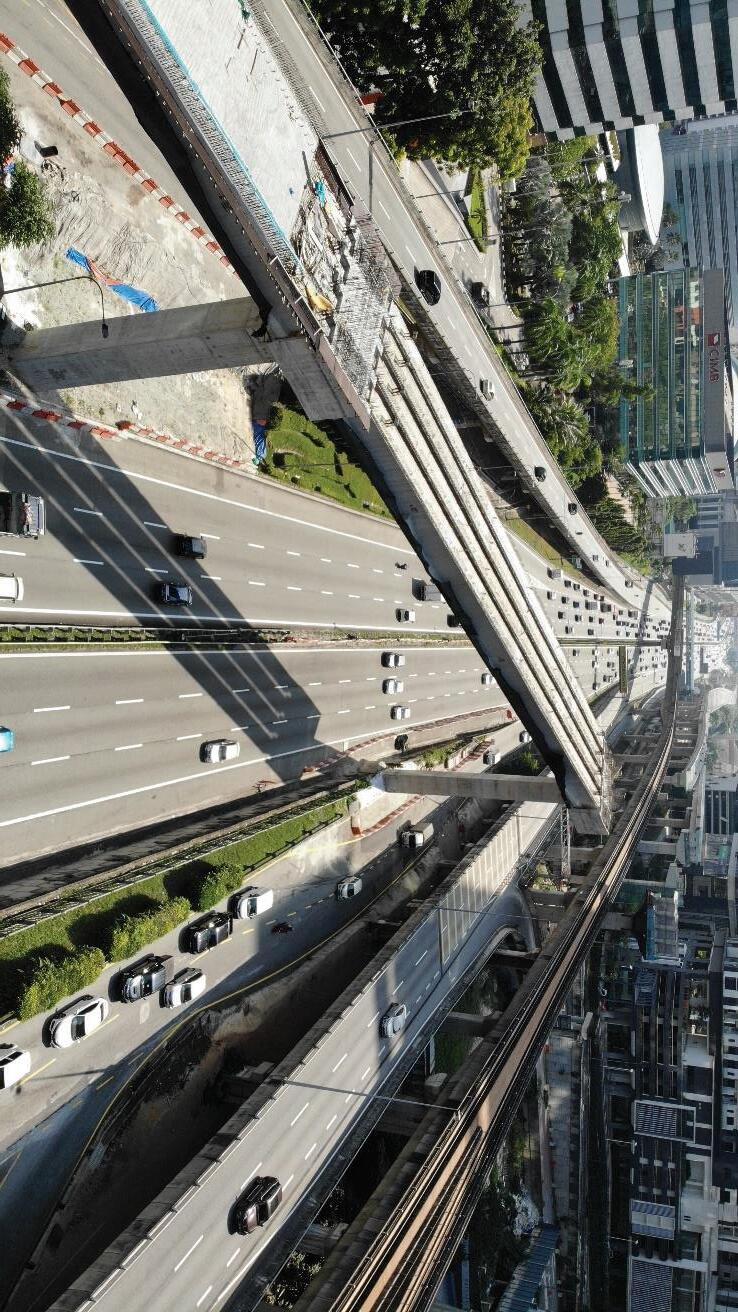







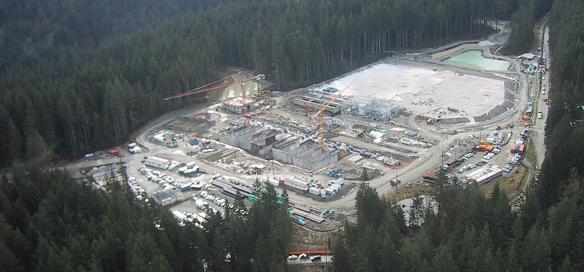

to 108 billion litres of water per day and supplies up to 70% of the drinking water to Metro Vancouver residences of the holding tanks and reservoir. Xypex Patch’n Plug and Xypex Concentrate were used to repair and stop seepage in approximately 305 metres of cold joints. website at ww w.xypex.com.au or LinkedIn page.








IEM Registered on 1 May 1959
MAJLIS BAGI SESI 2021/2022 (IEM COUNCIL SESSION 2021/2022)
YANG DIPERTUA / PRESIDENT
Ir. Ong Ching Loon
TIMBALAN YANG DIPERTUA / DEPUTY PRESIDENT
Ir. Prof. Dr Norlida bt Buniyamin
NAIB YANG DIPERTUA / VICE PRESIDENTS
Y.Bhg. Dato’ Ir. Ahmad Murad bin Omar, Ir. Mohd Aman bin Hj. Idris, Ir. Yau Chau Fong, Ir. Chen Harn Shean, Ir. Prof. Dr Leong Wai Yie, Ir. Mohd Khir bin Muhammad, Ir. Prof. Dr Ruslan bin Hassan
SETIAUSAHA KEHORMAT / HONORARY SECRETARY
Ir. Dr David Chuah Joon Huang
BENDAHARI KEHORMAT / HONORARY TREASURER
Ir. Fam Yew Hin
BEKAS YANG DIPERTUA TERAKHIR / IMMEDIATE PAST PRESIDENT Ir. David Lai Kong Phooi
BEKAS YANG DIPERTUA / PAST PRESIDENTS
Y.Bhg. Academician Tan Sri Datuk Ir. (Dr) Hj. Ahmad Zaidee bin Laidin, Ir. Dr Tan Yean Chin, Y.Bhg. Dato’ Paduka Ir. Keizrul bin Abdullah, Y.Bhg. Academician Tan Sri Dato’ Ir. Prof. Dr Chuah Hean Teik, Y.Bhg. Dato’ Ir. Lim Chow Hock
WAKIL AWAM / CIVIL REPRESENTATIVE
Ir. Yap Soon Hoe
WAKIL MEKANIKAL / MECHANIC AL REPRESENTATIVE
Ir. Dr Aidil bin Chee Tahir
WAKIL ELEKTRIK / ELECTRICAL REPRESENTATIVE
Ir. Francis Xavier Jacob
WAKIL STRUKTUR / STRUCTURAL REPRESENTATIVE
Ir. Gunasagaran Kristnan
WAKIL KIMIA / CHEMICAL REPRESENTATIVE
Ir. Dr Chong Chien Hwa
WAKIL LAIN-LAIN DISPLIN / REPRESENTATIVE TO OTHER DISCIPLINES
Ir. Dr Bhuvendhraa Rudrusamy
WAKIL MULTIMEDIA DAN ICT / ICT AND MULTIMEDIA REPRESENTATIVE
Ir. Jeewa Vengadasalam
WAKIL JURUTERA WANITA / WOMEN ENGINEERS REPRESENTATIVE
Ir. Noorfaizah Hamzah
WAKIL BAHAGIAN JURUTERA SISWAZAH / YOUNG ENGINEERS SECTION REPRESENTATIVES
Mr. Kuugan Thangarajoo, Mr. Lim Yiren, Mr. Naveen Kumar, Ms. Tan Wen Jia, Ms. Jacquelyne Anne Boudeville
AHLI MAJLIS / COUNCIL MEMBERS
Ir. Dr Tan Kuang Leong, Ir. Mah Siew Kien, Y.Bhg. Dato’ Ir. Mohd Azmi bin Ismail, Ir. Ng Yong Kong, Ir. Dr Mui Kai Yin, Y.Bhg. Dato’ Ir. Noor Azmi bin Jaafar, Ir. Ting Chek Choon, Ir. Sukhairul Nizam bin Abdul Razak, Ir. Lai Sze Ching, Y.Bhg. Dato’ Ir. Dr Ahmad Anuar bin Othman, Ir. Dr Chan Swee Huat, Ir. Ellias bin Saidin, Ir. Mohd Radzi bin Salleh, Dato’ Ir. Hj. Anuar bin Yahya, Ir. Dr Teo Fang Yenn, Ir. Prof. Dr Jeffrey Chiang Choong Luin Ir. Dr Siti Hawa bt. Hamzah, Ir. Dr Tan Chee Fai, Ir. Mah Way Sheng, Ir. Prof. Dr Zuhaina binti Zakaria, Ir. Lee Cheng Pay, Ir. Dr Kannan a/l M. Munisamy, Ir. Dr Siow Chun Lim, Ir. Wong Chee Fui, Ir. Dr Hum Yan Chai, Ir. Tiong Ngo Pu AHLI MAJLIS / COUNCIL MEMBERS BY INVITATION
Ir. Yam Teong Sian, Ir. Gopal Narian Kutty, Ir. Sundraraj a/l Krishnasamy PENGERUSI CAWANGAN / BRANCH CHAIRMAN
1. Pulau Pinang: Ir. Bernard Lim Kee Weng
2. Selatan: Ir. Wong Yee Foong
3. Perak: Ir. Loh Ban Ho
4. Kedah-Perlis: Ir. Mohamad Shaiful Asrul bin Ishak
5. Negeri Sembilan: Ir. Chong Chee Yen
6. Kelantan: Ir. Shaipuddin bin Shapii
7. Terengganu: Y.Bhg. Dato’ Ir. Wan Nazri bin Wan Jusoh
8. Melaka: Ir. Puvanasvaran a/l Perumal
9. Sarawak: Y.Bhg. Dato’ Ir. Janang Anak Bongsu
10. Sabah: Ir. Jeffrey Ng Vun Ping
11. Miri: Ir. Wong Siong Ung
12. Pahang: Ir. Ahmad Kamal bin Kunji
Number 10, OCTOBER 2021 Little
AHLI JAWATANKUASA INFORMASI DAN PENERBITAN/ STANDING COMMITTEE ON INFORMATION AND PUBLICATIONS 2021/2022
Pengerusi/Chairman: Ir. Prof. Dr Leong Wai Yie Naib Pengerusi/Vice Chairman: Ir. Prof. Dr Zuhaina binti Zakaria Setiausaha/Secretary: Ir. Dr Hum Yan Chai Ketua Pengarang/Chief Editor: Ir. Prof. Dr Leong Wai Yie Pengarang Prinsipal Buletin/ Principal Bulletin Editor: Ir. Prof. Dr Zuhaina binti Zakaria Pengarang Prinsipal Jurnal/Principal Journal Editor: Ir. Prof. Dr Abdul Aziz bin Abdul Samad Pengerusi Perpustakaan/Library Chairman: Ir. Dr Kannan a/l M.Munisamy Ahli-Ahli/Committee Members: Ir. Ong Guan Hock, Ir. Yee Thien Seng, Ir. Chin Mee Poon, Ir. Dr Oh Seong Por, Dr Sudharshan N. Raman, Ir. Dr Lai Khin Wee, Ir. Tiong Ngo Pu, Ir. Dr Lee Tin Sin, Ir. Yap Soon Hoe, Ir. Dr Teo Fang Yenn, Ir. Dr Bhuvendhraa Rudrusamy, Ir. Dr David Chuah Joon Huang, Ir. Tiong Ngo Pu, Ir. Lau Tai Onn, Ir. Yee Thien Seng, Ir. CMM Aboobucker, Mr. Muhd Ashiq Marecan bin Hamid Marecan
LEMBAGA PENGARANG/EDITORIAL BOARD 2021/2022 Ketua Pengarang/Chief Editor: Ir. Prof. Dr Leong Wai Yie Pengarang Prinsipal Buletin/ Principal Bulletin Editor: Ir. Prof. Dr Zuhaina binti Zakaria Pengarang Prinsipal Jurnal/Principal Journal Editor: Ir. Prof. Dr Abdul Aziz bin Abdul Samad Ahli-ahli/Committee Members: Ir. Lau Tai Onn, Ir. Ong Guan Hock, Ir. Yee Thien Seng, Ir. Dr Oh Seong Por, Dr Sudharshan N. Raman, Ir. Dr Lai Khin Wee, Ir. Dr Teo Fang Yenn Secretariat: Janet Lim, May Lee
THE INSTITUTION OF ENGINEERS, MALAYSIA Bangunan Ingenieur, Lots 60 & 62, Jalan 52/4, P.O. Box 223, (Jalan Sultan), 46720 Petaling Jaya, Selangor Darul Ehsan. Tel: 603-7968 4001/4002 Fax: 603-7957 7678 E-mail: sec@iem.org.my Homepage: http://www.myiem.org.my
Academic Research Project Management: Success Factors
Leadership in Project Management
From Cradle to the Grave: Project Management of Long Lead Equipment
Best Practices of Project Management: Capital Project Schedule Quality Assessment
Webinar Talk on Asset Management
Project Planning & Scheduling Using Microsoft Project Software
Webinar on the Journey of Engineers

Introductory Rate for New Advertisers

3,200/page RM 3,200/page
Full-Colour Advertisement
This one-time-only special rate o er is for new advertisers.
Space availability is subject to booking on a first-come-first-served basis.
Clients will provide ready-to-print artwork in PDF format with 300dpi.
Full page: 210mm x 285mm, 5mm extra bleed sizes for 4-sided with crop mark.
Advertising space must be utilised before 31 December 2021.
*Please note that the above rate will be subjected to 6% SST. For overseas advertisers, an additional 25% will be charged.
Rate shown above excludes 15% advertising agency commission.
Payment term: Full advance payment.
Artwork submission deadline is on (or before) the 1st week of the prior month of publication. After the material deadline, no cancellation or alteration to the advertisement will be entertained.
Any cancellation after signing the advertising order will result in a 50% penalty charge.
The publisher reserves the right to edit, revise or reject any advertisement deemed unsuitable or inappropriate.
JURUTERA has an estimated readership of 200,000 professionals. Our esteemed readership consists of certi ed engineers, decision making corporate leaders, CEOs, government o cials, project directors, entrepreneurs, project consultants, engineering consulting rms and companies involved with engineering products and services. Circulation & Readership Pro le
DIMENSION PUBLISHING SDN. BHD. [ 199701034233 (449732-T) ]
Level 18-01-02, PJX-HM Shah Tower, No. 16A, Persiaran Barat, 46050 Petaling Jaya, Selangor Darul Ehsan, Malaysia. Tel: +(603) 7493 1049 Fax: +(603) 7493 1047
E-mail: info@dimensionpublishing.com Website: www.dimensionpublishing.com
CHAIRMAN
ROBERT MEBRUER
CEO/PUBLISHER
PATRICK LEUNG
GENERAL MANAGER
SHIRLEY THAM ● shirley@dimensionpublishing.com
HEAD OF MARKETING & BUSINESS DEVELOPMENT
JOSEPH HOW ● joseph@dimensionpublishing.com
PRODUCTION EDITOR
TAN BEE HONG ● bee@dimensionpublishing.com
CONTRIBUTING WRITERS
PUTRI ZANINA ● putri@dimensionpublishing.com
HANNA SHEIKH MOKHTAR ● hanna@dimensionpublishing.com
SENIOR GRAPHIC DESIGNER
SUMATHI MANOKARAN ● sumathi@dimensionpublishing.com
GRAPHIC DESIGNER
SOFIA ● sofia@dimensionpublishing.com
ADVERTISING CONSULTANTS
THAM CHOON KIT ● ckit@dimensionpublishing.com
ACCOUNTS CUM ADMIN EXECUTIVE
YEN YIN ● yenyin@dimensionpublishing.com
For advertisement placements and subscriptions, please contact: DIMENSION PUBLISHING SDN. BHD. [ 199701034233 (449732-T) ]
Level 18-01-02, PJX-HM Shah Tower, No.16A, Persiaran Barat, 46050 Petaling Jaya, Selangor Darul Ehsan, Malaysia. Tel: +(603) 7493 1049 Fax: +(603) 7493 1047 E-mail: info@dimensionpublishing.com
Subscription Department E-mail: info@dimensionpublishing.com
JURUTERA is published and printed monthly by Dimension Publishing Sdn. Bhd.
JURUTERA MONTHLY CIRCULATION: OVER 50,000 MEMBERS
Submission or placement of articles in JURUTERA could be made to the:Chief Editor
THE INSTITUTION OF ENGINEERS , MALAYSIA (IEM) Bangunan Ingenieur, Lots 60 & 62, Jalan 52/4, P.O. Box 223 (Jalan Sultan), 46720 Petaling Jaya, Selangor. Tel: +(603) 7968 4001/4002 Fax: +(603) 7957 7678 E-mail: pub@iem.org.my or sec@iem.org.my IEM Website: http://www.myiem.org.my
© 2020, The Institution of Engineers, Malaysia (IEM) and Dimension Publishing Sdn. Bhd.
PUBLICATION DISCLAIMER
The publication has been compiled by both IEM and Dimension with great care and they disclaim any duty to investigate any products, process, services, designs and the like which may be described in this publication. The appearance of any information in this publication does not necessarily constitute endorsement by IEM and Dimension. There is no guarantee that the information in this publication is free from errors. IEM and Dimension do not necessarily agree with the statement or the opinion expresssed in this publication.
COPYRIGHT
JURUTERA Bulletin of IEM is the official magazine of The Institution of Engineers, Malaysia (IEM) and is published by Dimension Publishing Sdn. Bhd. The Institution and the Publisher retain the copyright over all materials published in the magazine. No part of this magazine may be reproduced and transmitted in any form or stored in any retrieval system of any nature without the prior written permission of IEM and the Publisher.
COVER NOTE
LEADERSHIP IN PROJECT MANAGEMENT
by Ir. Dr Nor Azhar bin Mohd Arif Chairman, Project Management Technical Division
The COVID-19 pandemic has posed great challenges in how core organisational activities are conducted and resulted in disruptions to business operations in both public and private sectors. While capable leadership, great teamwork, positive attitudes, correct tools and right skills are required at all structural levels during times of crisis, effective leadership in project management is more important than ever as remote working situations look to remain the new norm.

This edition of JURUTERA looks at the importance of leadership in project management and the tone it sets that will echo through the ranks and ultimately determine organisation success. Elaborating further in the cover story, the Director General of Public Works Department Malaysia, YBhg. Dato’ Ir. Haji Mohamad Zulkefly bin Sulaiman, focuses on leadership and management skills and highlights the similarities and differences between the two. He concludes with “leadership is doing the right thing and management is doing things right” and “the two skill sets need to work together and cannot be separated”.
This and two other feature articles on Capital Project Schedule Quality Assessment and Success Factors in Academic Research Project Management, should deliver a good read to all.
EDITOR’S NOTE
KEY TO SUCCESS
by Ir. Prof. Dr Zuhaina binti Zakaria Principal Bulletin Editor
This month, the IEM bulletin highlights leadership in project management which is the key success factor in any project.
An effective leadership will encompass strategies, relevant tools and decision making in setting up the execution plan.
On the same note, the Editorial Board is continuously looking at ways to improve JURUTERA . Recently, we organised a readership survey with the aim to gather feedback and perception from IEM members. Among the questions asked were their preferences in the type of articles published and their favourite sections or columns.

It is interesting to note that most respondents have indicated that they prefer technical articles which are relevant and useful to engineering practices. On the other hand, there are also comments from respondents who would like to see more articles such as success stories of Malaysian engineers and non-technical stuff.
The editorial board will conduct a thorough analysis in our bid to strike a balance and produce a new look JURUTERA next year. To do this however, we will need more contributions of quality articles and we will love to have more volunteers to help in the editorial work. Thus, we welcome members who can contribute their time and talents. Together, we will be able to do great things!
Leadership in Project Management

The Public Works Department (PWD) or Jabatan Kerja Raya (JKR), which falls under the purview of the Ministry of Works, Malaysia, is responsible for infrastructure development and maintenance projects including roads, buildings, airports, ports and jetties. Established in 1872, PWD is the Government’s lead technical agency. Last year, YBhg. Dato’ Ir. Haji Mohamad Zulkefly bin Sulaiman was appointed its Director General.
“As principal consultant to the Government, our main objective is to deliver products and to perform maintenance services within stipulated times, at high quality and reasonable cost to ensure optimal
asset benefits,” he said. As strategic partner to the various ministries, departments and agencies in managing the stipulated government policies, he added, PWD strives to be a leader in asset management, project management and engineering excellence for the nation.
LEADERSHIP VS MANAGEMENT
In his opinion, management and leadership are two complementary qualities that are interrelated. As such, it is not possible to separate one from the other. Dato’ Ir. Haji Mohamad Zulkefly explained that, by and large, leaders inspire and motivate, while managers plan, organise and coordinate.
“Management and leadership are both performed by people. As is widely acknowledged, humans are complex species who are not easily divided into individual elements without any kind of interrelated components,” he said. “A leader sets his eyes on the bigger picture. On the other hand, a manager puts all the jigsaw puzzles pieces together.”
He said that while leaders have a clear understanding of strategic focus and the goals at hand, managers are equipped with the technical know-how and skills required for accomplishing the goals prescribed.
But, he conceded that while there is a significant difference between the functions of leadership and
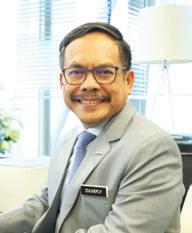
management, there are many areas where the traits or characteristics of both may overlap. In the context of executing a project, one will have to work as both a leader and a manager. The trick is in choosing when to switch roles and great skills are needed to manoeuvre the shift. “Here, a manager’s task is to optimise production and get the team to meet strategic goals while leaders inspire the organisation and the employees to achieve the strategic future,” he said.
Take for example,effective decisionmaking and problem-solving skills. While both are prime responsibilities of a leader and a manager, he said “the level of commitment may be different as leaders may be responsible at portfolio or programme level while managers hold the fort at project or operational level”.
He said communication is important at both management and leadership levels. Team members need to be informed and educated about the operating procedures. Therefore, leadership includes communication as well as inspiring and empowering people to do their best and building stronger relationships with the stakeholders.
Meanwhile, effective decisionmaking and problem-solving is the
YBhg. Dato’ Ir. Haji Mohamad Zulkefly bin Sulaiman was appointed Director General of the Public Works Department (PWD) on 23 July 2020. He graduated from University of Malaya with a Bachelor's in Civil Engineering and holds a Master’s in Asset & Facilities Management from Universiti Teknologi Malaysia. He has over 35 years’ experience, serving as a civil engineer with PWD in various offices and positions. He also has diverse and extensive experiences in the fields of project management, design, asset management, technical advisory services, public management and value management. He is currently President of the Board of Engineers Malaysia (BEM) and the Malaysian Asset & Project Management Association (MAPMA).
responsibility of both manager and leader. He explained that since the levels of commitment may be different, leaders may be responsible at organisational or portfolio or programme level, while managers ensure smooth operation at team, departmental or project level.
From the context of project execution within PWD, Dato’ Ir. Haji Mohamad Zulkefly said the department has in place a clear leadership and management structure to ensure successful project delivery. “In any given project, there will be three main entities that are involved internally, namely Head of Project Team (HOPT), Head of Design Team (HODT) and Superintending Officer (SO),” he explained.
HOPT is fully responsible for leading and managing the project to meet the needs and expectations of the clients. HODT focuses on the technical aspects of the project based on the scope, time and cost requirements as defined and planned by the HOPT. The SO undertakes the role of administrator to supervise, monitor and control the project in accordance with the terms and conditions stipulated in the contract.
“It can be said that, in PWD, the HOPT acts as a leader while the HODT and the SO assume the
managerial role in project execution. In this instance, I would consider management to be a subset of leadership,” he added, offering Figure 1 as a visual descriptor.

He stressed that leaders and managers should work in collaboration to manage change or crisis. “In the case of PWD, they need to quickly adapt to change when necessary. While leaders have a clear understanding of organisational change, managers have better knowledge on how to cascade the change initiatives and the alignment among the team members,” he said, adding that he has always emphasised on the need for leaders or managers to be speedy in decisionmaking.
“I am of the view that making a wrong decision is better than not making a decision at all,” he said.
Figure 1: Different roles in JKR project execution
In a nutshell, Dato’ Ir. Haji Mohamad Zulkefly said that for an organisation to ensure the success of its operations and strategic direction, it would need leaders and managers with positive traits.
IS THERE A DIFFERENCE BETWEEN THE TWO?
In the context of project environment, there is a school of thought that management relies on authority while leadership relies on influence.
For Dato’ Ir. Haji Mohamad Zulkefly, the main differences between management and leadership lies in how each motivates the teams to achieve the project objectives.
In the case of project management, the managers rely on their authority to ensure the project is delivered in accordance with certain predefined project objectives. “The project manager is responsible for directing, coordinating and controlling the work of others and making sure work gets done as planned. His/her primary role is to deliver the client’s requirements within the agreed parameters of time, cost and quality,” said Dato’ Ir. Haji Mohamad Zulkefly.
On the other hand, leadership is concerned with setting goals, making improvements to existing ways of working, motivating and leading the project teams to achieving betterment for the project. “Leadership is characterised by behaviours such as sharing an inspiring vision, producing useful change, leading by example, empowering others and creating the most conducive environment for the project team to succeed,” he said, adding that it is not about specific skills and knowledge but more about approaches and the relationships among the team members.
As such, he said, PWD requires both management and leadership as these support the organisation towards leading technical and project implementation. “Project management skills and knowledge is crucially important in managing and implementing projects,” said
Dato’ Ir. Haji Mohamad Zulkefly, adding that leadership elements also complement it by ensuring the stakeholders are being managed and communicated with efficiently so as to create better relationships and satisfaction in terms of project delivery.
WHAT GOOD PROJECT LEADERSHIP BRINGS
According to Turner & Muller (2005), there are 11 core traits that contribute towards effective project leadership, namely good command of basic facts, relevant professional knowledge, continuing sensitivity to events, problem-solving and decisionmaking, social skills, emotional resilience, pro-activity, creativity, mental agility, balanced learning habits and self-knowledge.
When it comes to project management, Dato’ Ir. Haji Mohamad Zulkefly said effective leaders must always lead by example and must be able to inspire their teams towards successful project delivery. Those who hold high managerial positions in their respective organisations in the construction industry must possess a considerable amount of knowledge and skills in discharging their responsibilities.
“For instance,” he said, “through close monitoring and control, important issues relating to scope, cost and schedule constraints can be resolved amicably whenever they arise.” To ensure the effectiveness of project implementation, Dato’ Ir. Haji Mohamad Zulkefly said PWD’s top management continues to engage with officers from other ministries/ agencies so that all issues are resolved in an orderly and timely manner. “As such, the involvement of the top management of PWD, the SO or Project Director in exercising effective leadership, is critical to the success of the projects,” he added.
WHO IS RESPONSIBLE?
Leadership involves creating an inspiring vision while setting the forward direction for an organisation
and its workforce. As leadership is strongly associated with a process of social influence, it is vital that all members of the organisation share the responsibilities of leading the organisation towards achieving its intended goals.
“Organisations which prescribe to the notion of a shared leadership culture or transformational leadership are more likely to succeed and tend to outperform those with a traditional leadership structure (or what is called transactional leadership),” said Dato’ Ir. Haji Mohamad Zulkefly.
He said transformational leadership provides a better fit in today's complex work groups and organisations, where a leader works in tandem with teams to identify needed change, create a vision to guide the change through inspiration and execute the change with a committed workforce.
“Transformational leadership focuses on team-building, motivation and collaboration with employees at different levels to accomplish change for the better,” he said, adding that a transformational approach challenges the status quo and is more future-oriented, unlike transactional leadership which places emphasis on attaining pre-established goals and organisational boundaries.
He said the PWD structure is aligned well with the notion of transformational leadership through a clear and shared understanding of its vision and mission, aided by strategic and management, operation and technical expert domains.
“There are several key indicators of good leadership. The first is making sure project activities move forward according to a set pace as decisions are made in a timely manner. The second is making sure team members understand and are aligned to a common objective as well as know what the project is going to deliver. Finally, it is ensuring conflicts in the project are resolved quickly by managing issues before these escalate into a crisis,” said Dato’ Ir. Haji Mohamad Zulkefly.
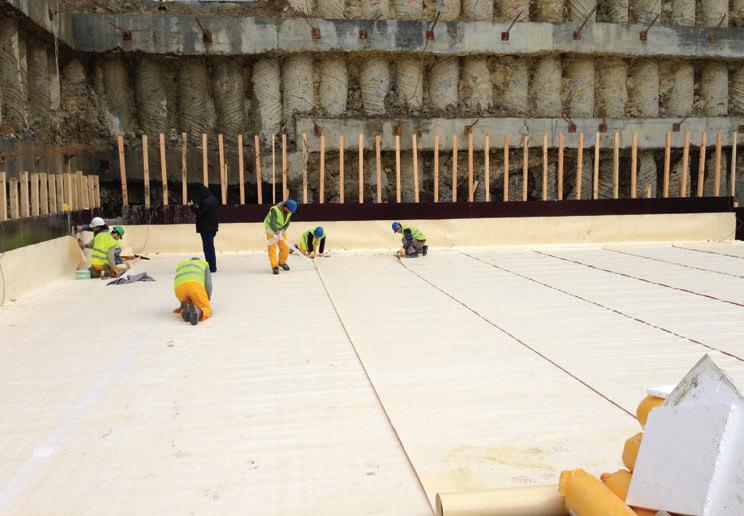
WISH TO KNOW MORE?
Contact our waterproofing specialist Danny Yap at +012 277 1680 or scan for more information Si kaP roo f®-80 8 i s a T PO ba s ed s h eet mem bran e for be l ow g rade wat erp roo fin g o f reinforc ed concret e s tr u ct ures . It is l oo sel y l aid on t o p r epa r ed s ub strates ba s e sl ab be for e r ein forc eme n t and c on crete . A s pecial hy bri d b ond i ng la y er for exc el lent me ch an ic al and c h em i ca l b ondi n g wi th t h e concret e t o ens ur e no la teral water unde r flow and m igrat i on be t ween t h e memb rane and the str u ct ural c onc rete.
APPLYING GOOD PROJECT LEADERSHIP
Project management includes many complex processes such as planning, organising, managing, controlling, budgeting, monitoring, testing and actualising a project, said Dato’ Ir. Haji Mohamad Zulkefly. Projects are realised and carried out with the help of those who are engaged in the total process of the project execution and completion. The manager is responsible for constructing, controlling and overseeing a project. “Overseeing means the manager is obliged to deliver the project successfully, while supervising and controlling the team’s efficiency,” he added.
According to him, leadership plays an essential function in the success of a project. “A manager is required to put on multiple hats while managing different project scenarios. He/she is required to apply skills of leadership in project management by being a team leader, excellent decision-maker, individual contributor, a people person, a subject matter expert and more,” he said.
He said project managers also require interpersonal skills, such as questioning, listening and speaking in order to initiate effective and persuasive interactions with team members. Honesty and integrity are two quintessential characteristics that project managers should have to enhance the confidence of clients, members, management and other stakeholders.
LEADERSHIP SKILLS: ACQUIRED OR NURTURED?
According to Dato’ Ir. Haji Mohamad Zulkefly, leadership is an experience that prepares one to deal with success and failure. While some people are born with leadership qualities, others can acquire these through diligence and hard work. “In my opinion, those born with innate qualities of leadership will still need a platform to develop and nurture these. For others it can also be acquired with the right motivation, guidance and
circumstance. It is an art that can be enriched with education, training and experience,” he said. “Leadership qualities require an individual to be honest, positive, hardworking, decisive, creative, influential, communicative and empathetic.”
To be an effective leader, he said a person must have the motivation to lead, the willingness to learn and the skills necessary to practise. “People can become great leaders with the right training and job experiences,” he said, adding that while educational programmes and training can teach style and technique, it is leadership skills that get polished with real experience.
This can be done formally through a training provider or informally through internal coaching on specific
skills and leadership competencies. One example is “technical skill” which provides the knowledge or core competency in a specialised area and activity.
Next is “human skill” which teaches the ability to work effectively with colleagues and to build a culture of trust and mutual respect in order to achieve organisational goals.
Finally, “conceptual skill” is the skill or ability to work on ideas and concepts.
Dato’ Ir. Haji Mohamad Zulkefly said mentoring programmes can help junior staff members by pairing them with a senior leader. This will offer the junior staff members the opportunity to benefit from the senior’s vast experiences and so be inspired to push forward and achieve goals.

Figure 2: Career Path model for PWD professionals
PWD has established career development policies to provide equal opportunities for all its officers to earn sufficient knowledge, skills and work experience in various key areas such as job placement in design, asset and project management offices. This job rotation model (Figure 2) helps officers acquire good leadership skills while further honing their core competencies.
MANAGING CONTRACTORS IN PROJECT MANAGEMENT
Dato’ Ir. Haji Mohamad Zulkefly said that PWD, as the primary executing agency to the client, needs to ensure project delivery and meeting strategic needs by delivering on the stipulated time, cost and quality. “It is more advantageous if the leader is someone with an excellent entrepreneurial mind and can think of projects outside the basic skill set. For better investment decision, in addition to communication and interpersonal skills, the ability to negotiate and resolve conflicts as well as to develop a sense of commitment within the team is essential,” he explained.
In many situations, a leader is responsible for determining the team’s direction throughout the project period by adopting leadership skills which can be adapted to the needs of the various situations. According to Dato’ Ir. Haji Mohamad Zulkefly,
depending on the task, team, organisational environment, manager capabilities, project resources, better control of risks and available time and budget, it is imperative that a project leader has the ability to manage the team to be more focused throughout the project as this helps ensure excellent project delivery.
LEADERSHIP OR MANAGEMENT SKILLS?
“A project manager is one who must be multi-skilled and competent in handling any kind of project in any given environment,” said Dato’ Ir. Haji Mohamad Zulkefly.
He added that in the construction industry, project managers have to deal with all kinds of difficulties and problems, including design and constructability, inter-contractor collaboration, engineering and safety concerns. This entails a set of activities that include overall project planning, coordination, tracking and control from start to finish to produce technically and financially viable projects that are completed on time and budget as well as to appropriate quality standards.
“To achieve this, a project manager must have management skills for him/ her to manage people and resources to deliver a project successfully. At the same time, a project manager must practise effective leadership skills
which require engaging with people and persuading them to 'buy-in' to a vision or goal,” he added.
In conclusion, Dato’ Ir. Haji Mohamad Zulkefly said: "A commonly coined phrase is that leadership is doing the right thing and management is doing things right. This illustrates how the two skill sets need to work together and cannot be separated.”

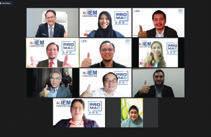

The Chairman of Project Management Conference (PROMAC 2021) provided details on the programme which will be officiated by the PWD DG
The enthusiasm of participants at the closing session of the PWD-PMTD virtual meeting is reflective of its effectiveness
Dear IEM members,
I am delighted to announce the launching of IEM’s very own Mobile App (on 14 April 2021)! Named “IEMGo”, this mobile app will enhance communication between IEM and its members. For a start, it will enable IEM members to connect to the IEM Community site for easy access to IEM Bulletin, IEM Journal, obtain information or first-hand announcements and to register for events. More features will be added in future to further enhance the app, such as providing job matching opportunities for members, enabling communication between IEM members and a host of other possibilities which we are exploring.
In fact, the need for IEM’s very own mobile app was one of the feedbacks we obtained from members in our first survey carried out during the MCO last year. We are very excited to have accomplished this in just one year and without incurring any cost for IEM. On this note, I would like to thank Silverlake – the developer of IEMGo and IEM Secretariat for its relentless efforts to make the app a reality.
I hope all our members will join the community under IEMGo and make this project a success. You can download the app from Google Play Store, Apple App Store or Huawei App Gallery.
We will be sharing the steps on how to install IEMGo and how to make use of the app in our email blast, social media channels and website. Should you need further information, please contact our Secretariat staff for assistance.
Finally, I would like to express my appreciation to the IEM Council and Excomm, the respective Committees and Members for their support and I look forward to the success of IEMGo.
Thank you. Stay Safe and Stay Healthy.
Ir. Ong Ching Loon, IEM President
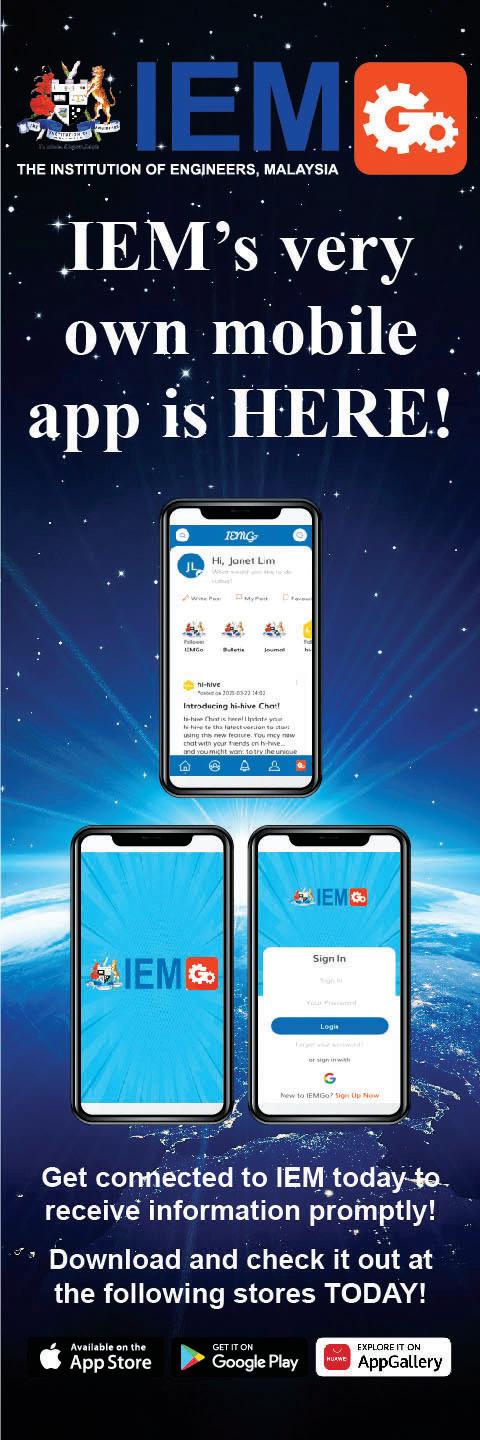

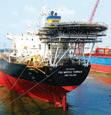
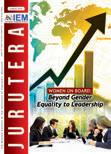

















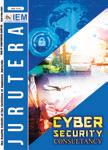















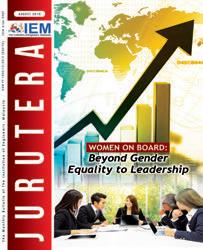
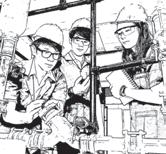























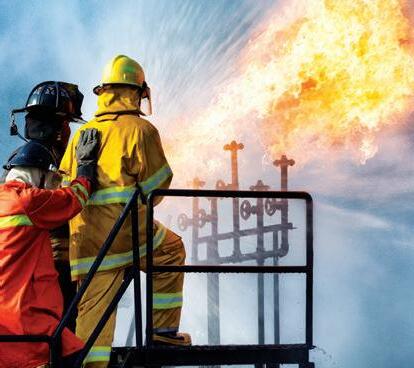





THE MONTHLY BULLETIN OF THE INSTITUTION OF ENGINEERS, MALAYSIA
JURUTER A

Circulation and Readership Profile



Advertising Benefits



JURUTERA has an estimated readership of 200,000 professionals. Our esteemed readership consists of certified engineers, decision making corporate leaders, CEOs, government officials, project directors, entrepreneurs, project consultants, engineering consulting firms and companies involved with engineering products and services.


Our business partners can be assured that their products and services will be given the circulation and exposure they deserve, thus maintaining a sustained advertising presence to our core readers of decision-making engineers and technical experts. Our website offers an even wider market reach, with added international presence, aided by our international affiliation with official engineering bodies all over the world. Our online and offline advertising features such as banner advertising, article sponsorship and direct e-mail announcements have proven to be successful marketing strategies that will set the businesses of our partners apart from their competition.
ADVERTISING RATES








ACADEMIC RESEARCH PROJECT MANAGEMENT: SUCCESS FACTORS

by Abang Annuar Ehsan


Idris Othman Mariatul Liza Meor Gheda
Academic research projects are by no means different from any other project which produces either products or services. However, it is uncertain whether Malaysian academics are aware of the success factors that lead to successful project completion.
Among the problems linked to project management are non-familiarity with the project management process, so there is a need to determine the factors which contribute to the successful completion of academic research project.
It is well recognised that many projects, in particular construction, manufacturing and information technology (IT) projects, carried out either by the government or private sectors, will adopt some kind of project management practices in order to ensure their successful completion. Project management is becoming a required leadership and management skill in many businesses (Mengel, 2008) especially for project-driven organisations, including institutes of higher learning.
The successful completion of any project has always been measured by the fulfilment of the golden triangle of cost, time and scope or quality. Academic research projects are by no means different from any other project which produces either product or services. The successful completion of an academic research project will still be bound by the way it is managed, in particular how the project management success criteria is fulfilled.
According to Bryman (2007), although research grants and contracts necessitated some level of project management, the focus of academics was normally on front-end planning and periodic budget reporting only. Their studies found that project management was not among the key leadership features for academics. Thus, there was a need to determine the criteria or factors from the perspective of project management practice which contribute to the successful completion of the academic research project.
PROJECT MANAGEMENT PRACTICES IN RESEARCH PROJECTS
Among the multitude of problems linked to project management over the entire project life-cycle are nonfamiliarity and unversed with either project management knowledge areas and processes, or the use of project management tools and techniques.
There are characteristics of projects which both research and non-research type projects share and differ. The capability of achieving monetary returns is adopted as a measure of success for industry-related projects. On the other hand, academic research focuses on knowledge creation through fundamental research and dissemination of knowledge. The similarities between industry-related and academic projects are what is described by the definition of project which is basically temporary, unique and producing deliverables including product, service or result (PMI, 2017).
In the early days of research at the university, guidance will come, apparently, from research supervisors or advisors. Nonetheless, novice researchers are ultimately expected to have the capability to develop their own projects and eventually see these completed. This is the common practice and setting faced by all academic researchers, typically at universities.
A few empirical investigations have assessed the relevance of classical project management practices in managing academic research projects. One example was that done by Riol and Thuillier (2015) involving the study to identify whether and to what extent traditional project management principles could be used to manage academic research projects. Mustaro and Rossi (2013) provided sound work on how project management principles, in particular the Knowledge Areas specified in the Project Management Body of Knowledge Guide, could be correlated with the research activities done in academic research. On the contrary, Huljenic, Desic and
Matijasevic (2005) stated that the lack of business orientation resulted in research projects being generally different in many ways from development projects, including approaches in planning, controlling and scheduling.
In his review, Alpert (2011) stated that it was not clear if academics utilised conventional project management processes or tools like those defined in the PMBOK Guide. Alpert also indicated that although research grants and contracts necessitated some level of project management, the attention was usually on front-end planning and periodic budget reporting only.
Success factors in project management may vary from one to another. Many research projects have been conducted to identify the success factors from the perspective of project management. Some have clustered these factors into major areas including external environment, project manager and team, projects and organisation (Othman, 2015).
Osorio et. al. (2014) and Ofori (2013) made extensive reviews on success factors and the 10 most highly critical factors included support by senior management, clear and realistic objectives, detailed planning, communication, client involvement, competent project team, effective change management, competent project manager, strong project mission and sufficient resources.
RESEARCH METHODOLOGY
In order to achieve the objective of this study which was to determine factors which contributed to the successful completion of academic research projects conducted at the university, the following methods had been adopted. Table 1 summarised the research method that was used to collect and analyse the data used in this study.
Research design
Type of research
Conceptual Framework
Target population
Sampling design
Data collection method
Data collection instrument
Data analysis method
(i) Sampling Design
Descriptive type
Quantitative
Correlational Studies
Academics at public university (project leader)
Stratified random sampling (quota)
Quantitative
Online survey using Google forms
Demographic profile, descriptive analysis, correlational analysis, relative importance index (RII)
The target population for this study were academics at public universities, in particular project leaders. Due to the limited resources and time constraints, the study focused only on 5 research universities (UKM, UPM, UM, USM and UTM). Based on the information obtained from these universities and applying Krejcie & Morgan’s table (Piaw, 2016) for determining sample size for a given population of about 3,500, a sample size of 346 was required for this study.
(ii) Data Collection: Questionnaires
The instrument used in this study was a set of questions using multiple scales approach. The questions were divided into two sections: Section 1 was on the respondents’ demographic information and Section 2 was on the main questions.
Our products:




No. 45-3, Jalan PJU 5/20
The Strand, Kota Damansara 47810 Petaling Jaya Selangor Darul Ehsan : 012 355 9151 : 012 329 3378 (Whatsapp only)
Tel : 603 6142 6638
Fax : 603 6142 6693
Email : leehuiseng@nehemiahwalls.com
Email : enquiry@nehemiahwalls.com
Table 1: Research method
FEATURE
The questions were designed based on those previously developed by Oren (Sundarasen, 2013). These questions were developed to align with the four process groups as defined by the Project Management Body of Knowledge Guide including the initiating, planning, executing and monitoring and control processes. Here, it was assumed that the academic research project followed a simple single phase project which had five stages, defined as initiating, planning, executing, monitoring and control and closing (Sanghera, 2019). A total of 23 questions were developed and distributed to the respondents.
(iii) Data Analysis
Questionnaire survey data was collected and analysed. Data analysis used in this study was based on demographic profile analysis, descriptive analysis, correlation analysis using statistical tools and the Relative Importance Index (RII). The RII approach was employed in the analysis of data for this research to rank the factors that affected the successful completion of projects. This would involve using formula as provided by Azman, Ramli & Razman (Azman et al., 2019).
RESULTS
The demographic profiles of the respondents were analysed using the simple frequency distributions procedure. The frequency table was generated from the Google Forms and then analysed using statistical tool.
Figure 1 showed the result in which respondents were asked if they were aware of any kind of project management practices applicable to their research project.
Figure 2 showed the result in which respondents were asked if they had heard of or were aware of existing project management practices including those derived from the PMBOK Guide, Prince2 methodology, Agile, CPM and others.
Figure 3 showed the result where respondents were asked about their current approach in managing their academic research projects.
Figure 1 showed that 62% of the project leaders were not aware of any type of project management practices throughout their career as academics. Only 18% had heard of or were aware of some kind of project management practices throughout their career as academics. Those who had heard of some forms of practices, had selected PMBOK, Prince2, Agile, CPM and others as the preferences of the practices known to them, as shown in Figure 2. On the other hand, those who had never heard of or were aware of some kind of project management practices responded by saying they were managing their projects based on experiences gained from previous work (52%), discussion with peers (20%), trialand-error (17%), consensus from team members (9%) and using ad-hoc approach (2%).
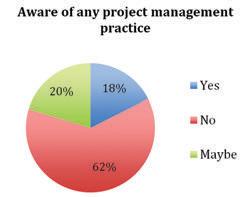

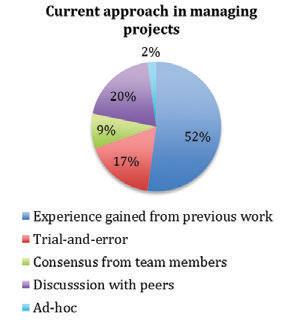
Figure 1: Response to questions on awareness in project management practices
Figure 2: Response to questions on project management practices in the industry
Figure 3: Response to questions on current approach in managing research projects
In Section 2, questions related to success factors were developed and distributed. The success factors had earlier been identified through literatures. These factors were utilised and presented as questions which enabled them to be evaluated in terms of importance and contribution to the successful completion of academic research project. Table 2 showed the summary of the results obtained from the survey questionnaires.
The initiating stage in project management was one of the critical stages, in particular the step in which approximately half of the respondents strongly agreed that leadership and problem solving abilities must be part of the early stage in project management. Similarly, in the planning stage, approximately half of the respondents strongly agreed that the project constraints – scope, cost, time and quality – must be closely managed and considered as part of the project management practice. Success factors at the executing stage had a slightly lower acceptance weightage as academics perceived the competencies of either the project leader or the project team to have only minor importance or contribution.
At the monitoring stage, several success factors were introduced to the academics. This stage was sometimes left out by many project leaders but here, the results showed that approximately half the respondents strongly agreed that communication must be practised by the team to ensure a successful project outcome. The respondents also agreed that the project constraints, in particular scope, cost and time, were the 3 most critical performance measures that must be monitored and controlled.
In addition to identifying the success factors from the perspective of their importance on project management practice, these factors were also ranked using the RII method. Table 2 also included the summary of rankings for the success factors. It showed that the 5 most highly ranked factors were leadership, change management, scope, scheduling and communication respectively. During the initiating stage, stakeholder management must be initiated and project leaders with substantial leadership virtues must be identified and appointed for approved projects. Change management at the monitoring stage was perhaps the least management area that was considered in any project. The results showed that academics intuitively agreed that managing change or having the ability to manage changes was critical to secure success of a project. The result also showed that successful projects required objectives to be clearly defined in order to manage scope constraints that could lead to scope creep. In addition to scope, developing a proper project schedule during the planning stage was considered a significant criterion in ensuring the successful completion of projects. Communication was one of the key management or knowledge areas in project management that should be regularly managed, in particular for project performance reporting.
Other than these 5 highest ranked factors, the remaining factors were notably important and should not be ignored.
CONCLUSION
The study on factors that contributed to the successful completion of academic research project showed that most academics were not aware of project management practices and were mostly managing projects based on their previous work experiences. A small number of academics used trial and error and ad-hoc approaches in managing their projects.
Success factors had been identified through the survey questionnaire and analysed using statistical tool. The results provided 23 success factors grouped into 4 process groups. The highest ranked factors from 1 to 5




FEATURE
included leadership skill, change management, clear and realistic objective (scope), project schedule and effective communication respectively.
The outcome of this study can still be further enhanced, in particular in obtaining larger population samples, which may include that from non-research universities in Malaysia.
REFERENCES
[1] Alpert, S. A. (2011). Project Management in Higher Education. University of North Carolina at Charlotte.
[2] Azman, N. S., Ramli, M. Z., & Razman, R. (2019). Relative importance index ( RII ) in ranking of quality factors on industrialised building system ( IBS ) projects in Malaysia. In 5th International Conference on Green Design and Manufacture (Vol. 2129).
[3] Bryman, A. (2007). Effective leadership in higher education: A literature review. Studies in Higher Education, 32(6), 693–710.
[4] Huljenić, D., Dešić, S., & Matijašević, M. (2005). Project management in research projects. Proceedings of the 8th International Conference on Telecommunications, ConTEL 2005, 2, 663–669.
[5] Mengel, T. (2008). Outcome-based project management education for emerging leaders - A case study of teaching and learning project management. International Journal of Project Management, 26(3), 275–285.
[6] Mustaro, N. P., & Rossi, R. (2013). Project Management Principles Applied in Academic Research Projects. Issues in Informing Science and Information Technology, 10, 325–340.
[7] Ofori, D. F. (2013). Project Management Practices and Critical Success Factors–A Developing Country Perspective. International Journal of Business and Management, 8(21), 14–31.
[8] Osorio, P. C. F., Quelhas, O. L. G., Zotes, L. P., Shimoda, E., & França, S. (2014). Critical Success Factors in Project Management: AnExploratory Study of an Energy Company in Brazil. Global Journal of Management and Business Research: Administration and Management, 14(10), 1–13.
[9] Othman, I. (2015). Risk Framework for Successful Completion of. Universiti Teknologi Petronas.
[10] Piaw, C. Y. (2016). Mastering Research Methods (2nd Editio). Shah Alam, Malaysia: McGraw-Hill Education.
[11] PMI. (2017). A Guide to the Project Management Body of Knowledge. Project Management Institute (6th ed.). Pennsylvania: Project Management Institute.
[12] Riol, H., & Thuillier, D. (2015). Project management for academic research projects: Balancing structure and flexibility. International Journal of Project Organisation and Management, 7(3), 251–269.
[13] Sanghera, P. (2019). PMP® in Depth. PMP® in Depth (3rd ed.). San Francisco, USA: Apress. doi:10.1007/978-1-4842-3910-0
[14] Sundarasen, P. (2013). Factors contributing to the success of projects in Malaysian companies. Universiti Tunku Abdul Rahman.
Ir. Dr Abang Annuar Ehsan, a senior lecturer at the Institute of Microengineering & Nanoelectronics, Universiti Kebangsaan Malaysia, is a professional engineer under BEM, a certified project management professional and a TTT certified trainer.
Assoc. Prof Ir. Idris Othman, is associate professor at Faculty of Engineering, Universiti Teknologi Petronas. He is a professional engineer under BEM, Asean Chartered Professional Engineer and holds the Total-France certificate for oil & gas.
Dr Mariatul Liza binti Meor Gheda , is a lecturer and programme director for Master of Project Management, Open University Malaysia. Her areas of specialisation include construction, project management, property & urban development and sustainable building.
Table 2: List of success factors and their ranks
Authors’ Biodata
BEST PRACTICES OF PROJECT MANAGEMENT: CAPITAL PROJECT SCHEDULE QUALITY ASSESSMENT

In the oil & gas industry, the foundation for a successful capital project delivery is having the right project management tools, specifically a quality project schedule for project execution. The baseline schedule, upon project sanction, will be updated on a monthly basis from start to completion. This will serve as a key reference point for all project team members and stakeholders on the monthly progress.
In this article, we will examine the industry best practices on quality assessment methods of the key project schedule which contribute to the successful on-time completion of capital projects.
CONTROLLING LEVEL-3 PROJECT SCHEDULES
Project scheduling is used for project planning, execution and efficient reporting. A good level-3 project schedule is designed to be a dynamic tool that helps in the planning of execution as well as provides an accurate project forecast of key milestone dates. The ultimate results of a level-3 project schedule can be found in the quality of the critical/longest path, which may be different if the schedule is not constructed correctly. Unfortunately, due to limiting reasons, some project schedules are prepared as a picture of the project team’s desired project dates rather than as a workable dynamic planning tool.
All elements are considered, where a quality level-3 project schedule must also accurately reflect the complete project scope of work, complexity level, available resources, productivity and applicable project risks. With these objectives in mind, it is very important that the baseline and updated level-3 project schedules are evaluated appropriately to ensure robustness for use throughout the execution of the entire project.
CAPITAL PROJECT SCHEDULE QUALITY ASSESSMENT METHODS
There are various scheduling quality assessment methods and guidelines available in the project planning and scheduling fraternity. One popular guideline was developed in 2005 in the United States by the US Defence Contract Management Agency (DCMA). This guideline essentially evaluates whether a project schedule is well built for adoption in US Federal government projects. The DCMA guideline checks whether the level-3 project schedule adheres to a set of best practices considered important to the success and manageability of a capital project. The DCMA has been refined and proven over the years through the monitoring of 14 points of project schedule quality guideline checks. In this article, we will explore the summary concept of the DCMA project schedule guidelines.
1. Checking the Logic: The first DCMA criteria to check is the level-3 project schedule logic. Two questions raised here include whether the project schedule logic is complete and whether there are missing links. A project schedule is a network of activities, so if the network is incomplete because of missing logic, an accurate project critical path will be impossible to determine. If there are dangling activities or activities with incorrect logic, the float values will not be accurate and the project critical path may not be identified correctly. As a result, the project team may end up formulating a completely inaccurate completion date.
For open-ended tasks in the schedule, one must consider closing all of them.
• If a task has no predecessor, it is substantial to try and find some other tasks, as this can potentially cause a delay. The task is left as open-ended only if it is the project start milestone.
by Ir. Wan Rizaluddin Abdullah bin Wan Ali

For enquiry please contact:
CRIB TECHNOLOGIES SDN BHD (564096-A), ARE WALL (M) SDN BHD (542608-W)
No. 28-2, Jalan Setia Utama AS U13/AS, Setia Alam, Sek U13, 40170 Shah Alam, Selangor
Tel: +603-3359 1227 (Hunting Line) Fax: +603-3358 7392
Email: groadesb@yahoo.com Website: http://www.ctsbare.com
If a task has no successors, it is crucial to try and find some other tasks. The task is left as open-ended if it is a project finish or reporting milestone. Looking for Leads: Negative lags, often referred to as “Leads”, can cause all sorts of problems when the level-3 project schedule is being updated monthly. All too often, negative lags are used to fix the start or finish dates but doing so extensively to allow activities to be planned in parallel with or to squeeze the required work into an unrealistic timeframe to meet project milestones will result in an unrealistic schedule. So the goal is to have zero negative lags.
Looking for Lags: The goal is to minimise the use of lags in the project schedule. Specifically, the goal is to have no more than 5% of relationships using lags in the level-3 project schedule. Like constraints, the use of lags should be kept to a minimum as otherwise, it will hinder free flowing paths and prohibit accurate float calculations for the total project critical path identification. In addition, when used excessively, lags can potentially cause incorrect start/finish dates.
The Right Relationship Types: Level-3 planning software Primavera P6 and Microsoft software support 4 relationships types. These are FinishStart, Start-Start, Finish-Finish and Start-Finish. The easiest link to use is StartStart but that does not mean project teams should build a schedule mainly on Start-Start relationships. In general, Finish-Start is the best. The best practice is that project schedules should use Finish-Start for 88% (or more) of the time, whereas Start-Start and Finish-Finish links should be kept to less than 6%. Start-Finish on the other hand can seriously impede the network logic of the project schedule. The goal is to have zero StartFinish relationships in the level-3 project schedule.
Hard Constraints: Project schedule hard constraints have a significant effect on risk analysis results. These should be used sparingly and only when the constraint reflects a real project situation. Constraints to be particularly aware of are:
Must Start On and Must Finish On – where preceding delays will not delay the task and preceding time savings will not bring it earlier.
Start On or After (SNET) and Finish On or after (FNET) – where preceding time savings will not bring the task earlier.
Consider removing these constraints and replacing them with logic (e.g. Finish-to-Start links) instead. The DCMA threshold for hard constraints is no greater than 5% of incomplete activities in the schedule. High Float Activities: High float activities may not be linked properly and can cause havoc to your level-3 project schedule critical path. The goal is to have less than 5% of activities of Float values of 44 days or more.
Negative Float: Negative float occurs when the project schedule is forecasting a missed deadline or when a hard constraint is holding a task further to the left than it would otherwise be. Ideally, avoid completely having any Negative Float in the level-3 project schedule. The DCMA practice is to see no negative float at all.
Long Duration Activities: When is an activity too long in the level-3 project schedule? When it is longer than 44 days and not exceeding 2 reporting periods (monthly). Limit long duration activities to no more than 5% of all activities in the project schedule. Alternatively, break down long activities into a series of shorter ones for more detail in the project schedule. Check for Invalid dates: No Actual Dates in the future, beyond your Data Date and no Forecast Dates in the past before your Data Date in the level-3 project schedule. The threshold for this metric is zero. This is one of the more critical metrics as tasks which violate this metric calls into question the validity of the rest of the project schedule.
10. Schedule Resource Loading: Ideally, all level-3 project schedules should be resource-and-cost-loaded. This will enable planners to look into more advanced indicators such as Earn Value metrics Schedule Performance Index (SPI). In practice, not all organisations resourceload their project schedules, so this is one of the more flexible metrics of the DCMA 14-point assessment.
11. Subvert Activity Slippage: It is generally desired that project teams deliver activities on time. This check looks at how many activities finish late when compared to the baseline plan. It is a good generic check to see if your project will deliver on time or not. The DCMA threshold for missed tasks is 5% although project schedule recovery at a certain point becomes unlikely after project schedule variance falls too far behind.
12. Critical Path Integrity: The 12th check is one that tests the integrity of the level-3 schedule’s critical path, looking for fluidity driven by good logic linking. The critical path test is a Boolean pass/fail metric intended to evaluate the integrity of the network logic in the project schedule. This test is performed by first identifying the critical path in the schedule, then intentionally introducing some amount of schedule slip to the first task on the path. If a commensurate amount of schedule slip occurs on the project finish milestone, the test has passed. At this point, DMCA checks that introducing a delay in the project schedule results in the finish date being equally delayed.
13. Looking for Lags Critical Path Length Index (CPLI):
The CPLI is one of the Trip Wire checks which is supposed to gauge the realism of completing the project on time. Its goal is to measure the ratio of the project critical path length and the project total float to the project critical path length. The critical path length is the time in work days from the current status date to “end of the programme.” The target number is 1.0 with a value of less than 95% as a failure to meet schedule on-time.
14. Baseline Execution Index (BEI): The BEI is meant to help project teams understand how well they are performing against the project baseline. It sums up how many activities are ahead of or behind schedule. A BEI of 1.0 means that the project teams are right on track while below 1.0 indicates behind schedule. DCMA says a BEI of less than 0.95 puts the project on notice.
CRITICAL PATH ANALYSIS
Once checks on the 14 points mentioned above have been conducted, the project team will have a schedule that shows “true” critical path. Therefore, any delay in activities along the project critical path will delay the project finish milestone.
Yet, a question arises: What else should project teams look for on the critical path to ensure correctness? The answer
is logic changes and whether these changes are logical and workable or, in other words, can they be implemented within the planned remaining execution works? Another item to check on project critical path is duration changes on activities that have not yet started (on what are these changes based?).
A final item to check on level-3 project critical path is expected finish dates and remaining durations. Based on the previous project schedule history, are these realistic?

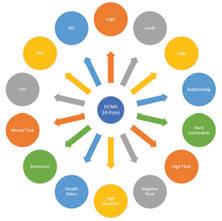
CONCLUSION
The project schedule quality assessment guideline checks which contribute to the successful completion of a capital project should implemented and regularly conducted for schedule assurance purposes. Should all project teams implement these guidelines in their respective projects? There are many different viewpoints on this question and these depend on how the other project risk elements are being managed.
Some project teams still use trial-and-error as well as ad hoc approaches to manage their projects schedules and they can be successful in delivering projects on time if they have a well-qualified and experienced project team. But as more digital checking software come into the market, it can definitely be noted that schedule quality checks are increasingly being accepted as standard practice in the planning and scheduling industry. As time goes by and based on this trend, more and more project schedules will be required to meet schedule quality guidelines as a mandatory requirement to ensure successful and on time capital project completion.
Author’s Biodata
Ir. Wan Rizaluddin Abdullah bin Wan Ali has over 23 years’ experience in project management and project control for oil & gas upstream, downstream and technology projects. He is a Professional Engineer (P.Eng.) registered with BEM and a committee member of IEM Project Management Technical Division.
DCMA 14-point Schedule Quality Check
Logo Defence Contract Management Agency (DCMA)
Print S er vice

ro mot ion ro mot io n
F lyer / Lea f le t
Art P aper (F ull Color )
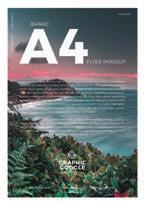
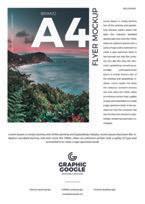

FLYER MOCKUP

500pc s RM130 1000pc s RM160 A4 105 g sm
500pc s RM160 1000pc s RM190 128 g sm 500pc s RM100 1000pc s RM130 A5 105 g sm 500pc s RM130
s RM160 128 g sm
Bus iness Card - 54mm x 90m m







ENGINEERING SDN. BHD. 199701015320 (430817-D)
SIMPRO
58, Plaza Puchong, Jalan Puchong Mesra 1, 58200 Kuala Lumpur, Malaysia.






As approved by Council and announced at the Annual General Meeting, IEM will be conducting the Council Elections for session 2022/2023 via electronic balloting.
This is to facilitate and enable more members to be able to participate in selection of members to represent them in the IEM Council.
However, to facilitate the smooth implementation of the electronic balloting, all Corporate Members are required to update their record in the IEM portal with their latest email addresses and mobile phone numbers.

DEADLINE
28 February 2022
FROM CRADLE TO THE GRAVE: PROJECT MANAGEMENT OF LONG LEAD EQUIPMENT

by Ir. Nur Azhani

The Project Management Technical Division (PMTD) ended 2020 with a webinar talk on From Cradle to the Grave: Project Management of Long Lead Equipment, on 10 December. Organised in conjunction with Hari Profesion Teknikal Negara 2020, the webinar had 60 participants despite the various restrictions during the COVID-19 pandemic.
The talk was delivered by the Deputy Chairman of PMTD (2020/2021), Ir. Dr Harris Abd Rahman Sabri. He started his career in the oil & gas industry as a maintenance rotating engineer in 2004 and had vast experiences in various turbomachinery and major rotating equipment packages, both in greenfield and brownfield projects. He is currently serving the Centre of Operational Excellence (COE) as leader of digital solutions related to rotating equipment.
Falling under the critical path of overall project schedule, managing the long lead equipment is undeniably the most challenging task in project management practice. The speaker enlightened participants on the delays and changes during the long lead equipment management that would adversely impact the overall project execution in terms of cost, quality and schedule. Therefore, from the project management perspective, having the right competency and knowledge was regarded as very crucial in managing such packages, from drafting the technical specification, procurement, detailed design, testing, installation, commissioning and handing over to the operation team.
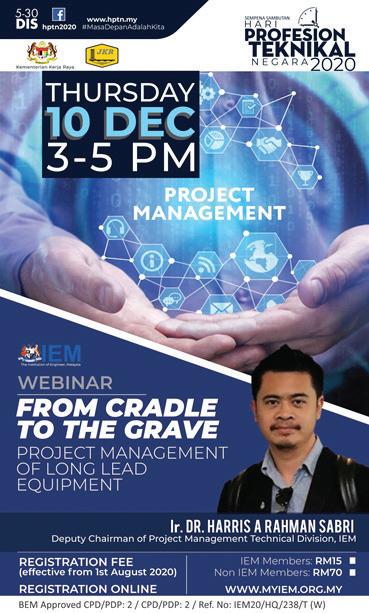
Ir. Assoc. Prof. Dr Syuhaida Ismail
The webinar was organised in conjunction with Hari Profesion Teknikal Negara 2020
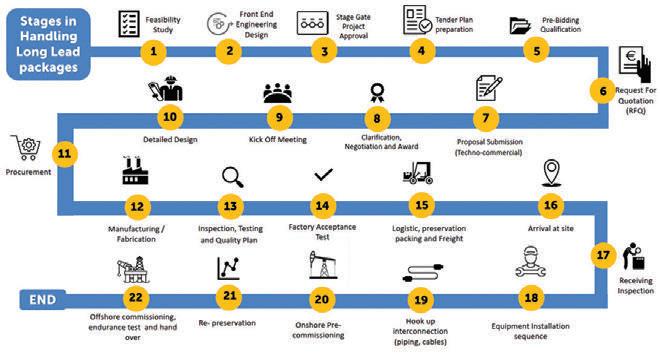
Wearing the hat of a package engineer, Ir. Dr Harris also shared his perspective and experiences in handling the various challenges in managing the long lead equipment which were deemed critical and thus could become another sub-project within the main project. Therefore, this criticality of managing long lead equipment warranted having its own “project manager”. He also underpinned the importance of identifying the typical project management processes in procuring long lead mechanical packages, appraising the expertise and competencies required in order to become an allrounder package engineer, analysing the associated risks in managing the long lead equipment as well as mitigating the risks and eventually exploring the best practices for managing long lead equipment within the industry.
During the Q&A session, participants asked many interesting questions which showed their active engagement and concentration throughout the session. Overall, the webinar achieved its aim to disseminate useful knowledge and information on the project management of the long lead equipment. In fact, many of the participants expressed hope that in the future, PMTD would organise a series of webinars on the specific project management process to give a complete insight on how to successfully manage the long lead equipment based on project management best practices.
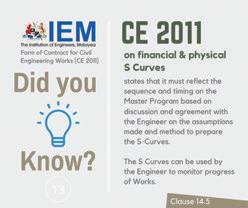
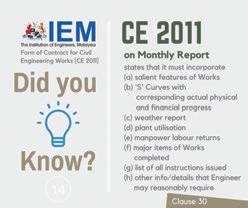
Project management of long lead equipment in a page as shared by the speaker during the webinar
Explore our full set of Professional and Integrated PUBLISHING MANAGEMENT SERVICES:
» Project Management
» Crea�ve Management
» Ad Space Management
» Mailing Management
» Print Management
• Annual Reports
• Booklets • Brochures
• Bun�ngs • Business Cards
• CD / DVD Replica�ons
• Calendars • Cards & Invita�ons
• Cer�ficates • Custom Prin�ngs
• Envelopes • Folders
• NCR Bill Books • Notepads
• Leaflets • Le�erheads
• Paper Bags • Posters
• S�ckers • Others




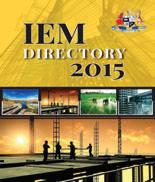


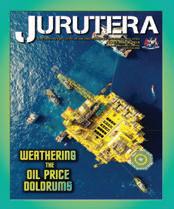




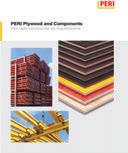




























Authorised Publisher: The Institution of Engineers, Malaysia (IEM) - JURUTERA
WEBINAR TALK ON ASSET MANAGEMENT


by Ainarull Assikin Abdul Hadi Ir. Assoc. Prof. Dr Syuhaida Ismail
On 5 March 2021, the Project Management Technical Division (PMTD) of IEM organised a webinar on Asset Management as part of a series of talks and courses on Asset Management in Project Management. Some 150 participants took part.
In general, it covered the definition of asset management and the 5 elements, consisting of structured programme, specified service levels, asset ownership minimisation costs, aligning costs and service levels as well as technology.
The speaker was Assoc. Prof. Dr Abd Rahman Abdul Rahim, a committee member of the PMTD, who had vast experiences working with two multi-national corporations in the area of manufacturing. He is also Associate Professor of Asset Management at Universiti Teknologi Malaysia Kuala Lumpur.
During his talk, participants were exposed to the essentials of asset management for better services, lower costs and sustainable infrastructure, which could be achieved through planning, procuring, installing, commissioning, monitoring, managing and disposing of their assets via a systemised approach. The participants were also told that, since assets must be managed effectively to improve productivity and efficiency with the least possible downtime to increase return on investment, a good maintenance system was a substantial part of asset management in order to prevent the incurring of unnecessary or additional costs due to unscheduled downtime or repair work. With such a system in place, companies could track the overall performance of their assets to ensure that all were being utilised efficiently.
Assoc. Prof. Dr Abd Rahman also stressed that while an asset management system allowed the monitoring and review of performance, there were cases that needed the action of acquiring, upgrading, depreciating, adjusting and re-categorising, transferring and retiring the asset.
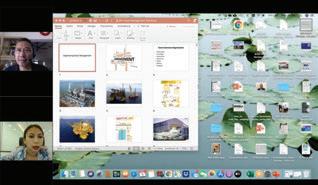
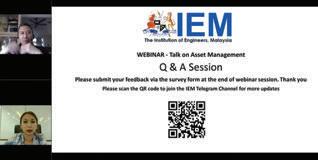

Some snapshots from the webinar on Asset Management
FORUM
He then touched on maintenance management systems, one of the main components of asset management. This consisted of computerised maintenance management systems (CMMS) and enterprise asset management systems (EAMS) which provided a realistic way to reduce expenses and increase revenues. Participants were also informed of the advantages of using asset management systems for
maximising output, improving planning and scheduling, reducing labour costs, retaining knowledge, enhancing operational performance, reducing inventory, complying with regulations, adding agility into operations, managing risk and increasing availability and reliability.
Towards the end of the webinar, a lively Q&A session saw participants posting numerous questions for Assoc. Prof. Dr Abd Rahman.
UPCOMING ACTIVITIES
Webinar - Talk on An Overview of Rare Earth Elements (REE): Introduction, Extraction Method and Its Potential in Malaysia
Date : 16 October 2021 (Saturday)
Time : 10.00 a.m. – 12.00 p.m.
Venue : Digital Platform
Approved CPD : 2
Speaker : Dr Ismail Ibrahim
Virtual Half Day Seminar on “Geosynthetics”
Date : 20 October 2021 (Wednesday)
Time : 2.00 p.m. – 6.30 p.m.
Venue : Digital Platform
Approved CPD : 4.5
Speakers : Mr. Chris Lawson & Mr. Mike Dobie
Webinar Talk on “Design of Deep Soil Mixing Using Lattice Arrangement for Deep Excavation”
Date : 21 October 2021 (Thursday)
Time : 3.00 p.m. – 5.00 p.m.
Venue : Digital Platform
Approved CPD : 2
Speaker : Er. William Chong
Webinar Talk on “Probabilistic Schedule Risk Analysis”
Date : 23 October 2021 (Saturday)
Time : 11.00 a.m. – 1.00 p.m.
Venue : Digital Platform
Approved CPD : Applying
Speaker : Ir. Faizal A. Sanusi

Complete Chlorination System Solution

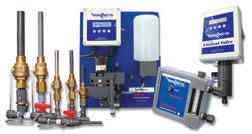





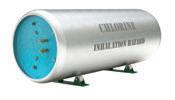


MINERAL TERRAMESH®
Mineral Terramesh® is a unique and simple to install soil reinforcement system with a sloping rock face finish. It is ideal for use where a modern, clean faced aesthetic is preferred.
Mineral Terramesh® can be used either alone or in conjunction with our MacGrid or MacDrain geosynthetics depending on the height of the reinforced soil structure.
Mineral Terramesh® is an environmentally friendly modular system. When used with MacGrid or MacDrain, site-won materials can often be used as structural backfill to the reinforced soil slope. This has a triple benefit to the client:
No need for expensive quarried granular materials to be imported for structural backfill
No need to dispose of site-won soils into landfill
Fewer truck movements on roads around the project site

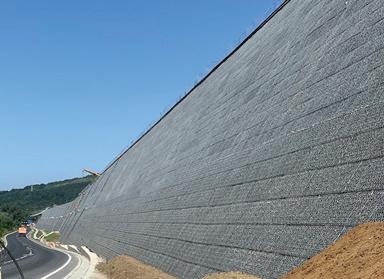







Unit 511, Block G, Phileo Damansara 1, No. 9, Jalan 16/11, Off Jalan Damansara, 46350 Petaling Jaya, Selangor Darul Ehsan, Malaysia.
Maccaferri (Malaysia) Sdn. Bhd.

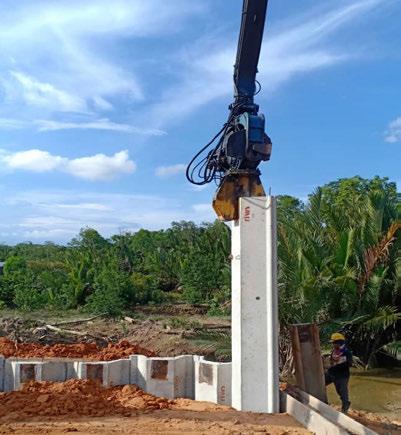



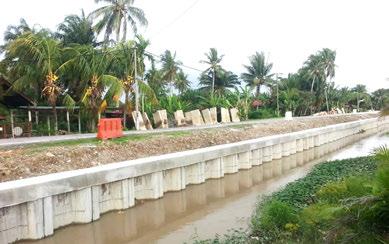

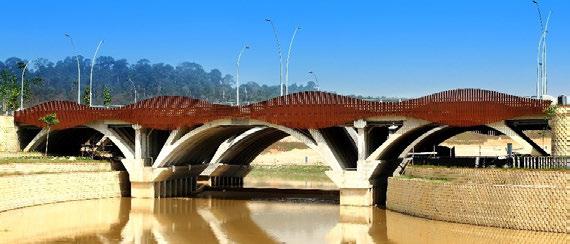
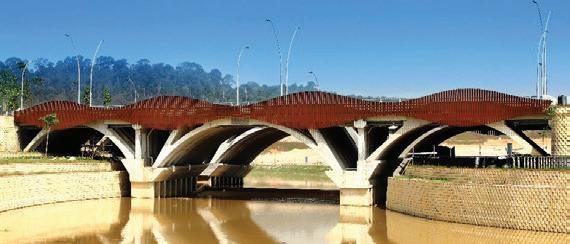

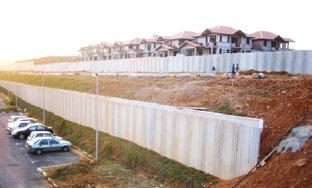

PROJECT PLANNING & SCHEDULING USING MICROSOFT PROJECT SOFTWARE

by Ts. Lim Yiren
The Institute of Engineers, Malaysia, Young Engineers Section (YES), recently organised a 2-day course on Project Planning & Scheduling – Including MS Project Software Practice via digital platform Zoom. It attracted 42 participants from engineering and non-engineering backgrounds, of which 32 were Graduate and Student Members.
On Day 1, the trainer, Ir. Frankie Chong, talked about project life-cycle which focuses on the planning phase. Essential topics covered included the identification of project needs, the construction of a Work Breakdown Structure (WBS), creation of a precedence table and the network diagram including the arrow-on-node (AON), the critical path, idling and float times as well as techniques and skills for compressing the project duration. This knowledge can only be developed with regular practice and through application of the basic principles in actual situations. The methodology will help in the development of an overall plan that will meet the customer’s expectation.
In addition, Ir. Chong introduced PERT analysis as an alternative to critical path analysis. This network analysis tool can be used to estimate project duration. The threepoint estimate from PERT will provide a better prediction of project duration based on considerations of variance and standard deviation. PERT analysis was first used in the US Polaris project.
During the session, the participants shared and actively discussed their own experiences on the significance of the S-Curve in the Project Life-Cycle. The purpose of the S-Curve is to track and manage project costs. It gives an original versus revised comparison of the costs incurred (from activities) over time (duration). Participants acknowledged that the S-Curve is regularly depicted in progress reports and indicates the progress of the project in comparison with the recommended schedule.
The role of quality management plans, such as the ISO 9000 series, in project planning and implementation was also discussed.
On Day 2, the focus shifted to project scheduling.
Step-by-step guidance was given in developing the project schedule using Microsoft (MS) Project software. After going through the major chapters and tutorials, the participants, who worked in groups, were asked to perform a case study as well as undergo a practical assessment. They were required to demonstrate their understanding of project planning and scheduling principles and techniques using the MS Project software, which encouraged group discussion and teamwork. The utilisation of such software will enable the delivery and execution of project plans in a professional manner and allow for the subsequent monitoring, control and necessary interaction until completion.
In conclusion, engineers, engineering technologists and engineering technicians were encouraged to apply project management principles at their workplace and in daily life as well as to undergo continuous professional development or lifelong learning for personal and career advancement. Through project management, a project team can avoid costly mistakes by gaining an insight into the success and failure factors of projects, assess and mitigate project risks, estimate project costs and budgets using simple and proven techniques and apply the best practices in planning, scheduling and reporting.
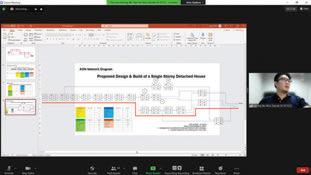
Presentation by Mr. Dennis Ng on the Group Exercise on Network Diagram and Critical Path Analysis.
WEBINAR ON THE JOURNEY OF ENGINEERS

by Goh Yong Sheng


Awebinar titled The Journey of Engineers was held on 7 May 2021 from 2pm to 4pm via Online StreamYard and Facebook Live. It attracted 151 participants from various engineering schools.
It was aimed at giving students a better understanding of the right skills and competencies required for them to become successful engineers. It also gave them an insight into the actual working lives of engineers as well as the challenges and ways to overcome them.
Two prominent speakers were invited. They were Ir. Dr Lim Jeng Shiun, the deputy director of Process Systems Engineering Centre, UTM, and Ir. Lim Gee Zhiong, the director of AFI Project Management Consultancy Sdn. Bhd.
The interactive webinar session enabled the students to ask the speakers various questions. The feedback from most of the participants was positive as they felt the webinar had provided them with more knowledge about the real working environment in engineering.

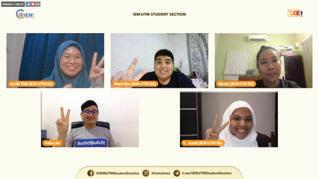
Members of the committee with Ir. Dr Lim Jeng Shiun
Members of the committee with Ir. Lim Gee Zhiong

LITTLE RAILWAY OF LAKE DISTRICT
On our first visit to the Lake District in November 2008, my wife and I were profoundly enthralled by the peaceful laidback ambience and charming scenery of the English countryside. When we visited again in March 2017, we decided to take a ride on its famous mini-train that we had missed on our earlier trip.
The heritage railway was first built in 1875. It runs from Ravenglass on the Irish Sea coast inland for 11.3km to Dalegarth station near Boot in the valley of Eskdale.
This short side line railway, originally of 914mm gauge, was constructed to transport iron ore from the mines at Boot to Ravenglass, where it was transferred to the main coastal railway. The side line was later upgraded to accommodate passenger trains and became the first public narrow-gauge railway in England. However, the escalating cost of maintenance and operation, coupled with falling demand due to closure of the mines, led to the discontinuation of the service in 1913.
A business partnership acquired the abandoned line, converted it to 381mm gauge and resumed train services in 1915. Downsized locomotives and rolling stock were ordered to run on the narrower railway, incorporating parts salvaged from the scrapped rolling stock.
Ownership changed hands again in the mid-1920s. Sections of the line were re-laid and both horizontal as well as vertical alignments were improved. Ravenglass station was rebuilt to cater to increasing passenger traffic, while new steam and diesel locomotives were acquired.
The Second World War and another change of ownership, however, resulted

is a
civil engineer who derives a great deal of joy and satisfaction from travelling to different parts of the globe, capturing fascinating insights of the places and people he encounters and sharing his experiences with others through his photographs and writing.

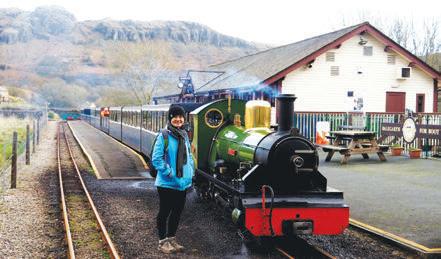
in the railway falling into dire financial straits. The Ravenglass & Eskdale Railway Preservation Society, formed by a group of locals and railway enthusiasts with the backing of a politician and some financiers, managed to salvage the railway from closure at an auction in September 1960. The line, now known officially as Ravenglass & Eskdale Railway but affectionally referred to as La’al Ratty (“Little Railway”) by the locals, has since been operated by a new company under the auspices of the preservation society.
Today, trains operate throughout the year except in January, providing a unique travelling experience for 120,000 passengers annually. The locomotives are 1/3 full size and the operation is entirely handled by volunteers.
We travelled from Ambleside to Ravenglass by a long route because there was no direct bus service between the two towns. We first got to Kendal by bus and then to Barrow-in-Furness in another bus, and finally arrived at Ravenglass after a 45-minute train ride up the coast.
The mini-train, powered by a diesel locomotive, left the station at 13:50 hrs. The 11.3km journey took 40 minutes, passing through 7 halts at which the train would only stop upon request. The carriages were either covered or open. We chose to sit in the latter for better enjoyment of the pretty views. We were extremely lucky to see a few very colourful pheasants in the wild.
At Dalegarth Station, the diesel locomotive detached itself from the train, moved onto a large turntable and was manually rotated 180°. It then chugged on to the other end of the train by way of a shunting line and attached itself to the train again for the return journey. We spent a little more than an hour at the station, enjoying the views and spending time in the warm and cosy café and gift shop in the station building while waiting for the next train to arrive. To our great delight, our return journey was powered by a very handsome 100-year-old steam locomotive known as River Irt
What a fabulous heritage railway and a most memorable train journey indeed!
Ir. Chin Mee Poon
retired
Ir. Chin Mee Poon
Subscribe to IEM’s Publications Now!
Yes! I would like to be a subscriber of The Institution of Engineers, Malaysia’s publications
Name: _________________________________________________________________________________________________________
Mailing Address: _________________________________________________________________________________________________
Country: ________________________
Company/Institution: ______________________________________________________________________________________________
Title: ____________________________________________________________________________________________________
Telephone No: _________________________ Fax: _________________________ Email: _________________________________
New Subscriber Renewal
Please commence my subscription from: _________________________(month/year) Signature: _______________________________
To start your subscription of IEM’s publications, complete this form and mail it back to the address below. For faster processing, fax it to: +603 7493 1047. Thank you.
What is your primary job title?
Corporate Management (including chairman, president, proprietor, partner, director, vice president, general manager, division manager, import/export manager, other corporate title)
Management (including project/contract/equipment/service/transport district manager, clerk of works, other technical or operating manager)
Engineering/Design (including chief engineer, chief designer, civil/ highway/mechanical/planning engineer, other engineering/design title)
Buying/Purchasing (including chief buyer, buyer, purchasing officer, other buying/purchasing title)
Titles allied to the field (architect, consultant, surveyor, research and development professor, lecturer, supervisor, superintendent, inspector or other allied title)
Others (please specify) ____________________________
What type of organisation do you work in? (Tick one box only)
Contractor
Sub-contractor specialist
Design and build contractor
Consulting engineering/architectural/quantity surveying practice
Mining/quarrying/aggregate production company
Petroleum producer
International/national authorities
National/regional/local government
Public utilities (electricity, gas, water, deck and harbour, other)
Manufacturer
Distributor/importer/agent
Construction department of large industrial/Commercial concern
Association/education establishment/research
Construction equipment hire/rental company
Project/construction management consultancy
Others (please specify) _______________________________

What are the main activities of your organisation? (Tick all that apply)
Constructions of:
Roads/bridges
Manufacturer of:
Construction equipment
Dams/reservoirs/irrigation Cement
Harbours/offshore structures Other construction materials
Foundations/tunnels Distribution Pipelines/refineries Construction equipment
Structures/steel work Construction materials
Building (commercial, industrial) Hire/rental of construction equipment
Housing Design
Construction management Earth-moving/open cast mining
Deep mining Aggregate production
Others (Please specify) _________________________________________
Rate (Please tick)
RM360.00 - 12 issues of JURUTERA
RM84.00 - 2 issues IEM Journal (Half-yearly)
Terms and Conditions:
1) The subscription is to be prepaid.
2) Please make cheque payable to Dimension Publishing Sdn. Bhd.
3) Subscriptions are not refundable.
4) Magazine/s will be sent to the mailing address given.
5) Students are entitled for a 20% discount from the above subscription rate.
6) Students must submit a photocopy of the student identification card together with the payment.
7) The above rate is inclusive of delivery charges and applicable in Malaysia only.
8) Additional delivery charges will apply to overseas subscribers.
For subscription enquiries, please contact +603-7493 1049 or email to info@dimensionpublishing.com
Kepada Semua Ahli,
TEMUDUGA PROFESSIONAL
Tarikh: 8 September 2021
SENARAI CALON-CALON YANG LAYAK MENDUDUKI
TEMUDUGA PROFESIONAL TAHUN 2021
Berikut adalah senarai calon yang layak untuk menduduki Temuduga Profesional bagi tahun 2021.
Mengikut Undang-Undang Kecil IEM, Seksyen 3.8, nama-nama seperti tersenarai berikut diterbitkan sebagai calon-calon yang layak untuk menjadi Ahli Institusi, dengan syarat bahawa mereka lulus Temuduga Profesional tahun 2021.
Sekiranya terdapat Ahli Korporat yang mempunyai bantahan terhadap mana-mana calon yang didapati tidak sesuai untuk menduduki Temuduga Profesional, surat bantahan boleh dikemukakan kepada Setiausaha Kehormat, IEM. Surat bantahan hendaklah dikemukakan sebulan dari tarikh penerbitan dikeluarkan.
Ir. Dr David Chuah Joon Huang Setiausaha Kehormat, IEM (Sessi 2020/2021)
PERMOHONAN BARU / PERPINDAHAN MENJADI AHLI KORPORAT
Nama Kelayakan
KEJURUTERAAN MEKANIKAL
IKHWAN NASIR BIN ALWI BE HONS (UTM) (MECHANICAL - AUTOMOTIVE, 2006)
PERPINDAHAN AHLI
No. Ahli Nama Kelayakan
KEJURUTERAAN AWAM
43322 LOOK KUAN CHUNG BE HONS (UMS) (CIVIL, 2012)
52530 SEE WAN CHUAN BE HONS (UTHM) (CIVIL, 2010)
KEJURUTERAAN ELEKTRIKAL
49188 TAY KIAN AIK BE HONS (UNITEN) (ELECTRICAL & ELECTRONICS, 2013)
94699 MOHD SAIFUL HAFIZI BIN ZAKARIA BE HONS (UiTM) (ELECTRICAL, 2013)
KEJURUTERAAN MEKANIKAL
43848 MOHD ASYRAF BIN MOHD RAZIB ME HONS (SHEFIELD) (MECHANICAL, 2008) PhD (IIUM) (ENGINEERING, 2018)
SENARAI PENDERMA KEPADA WISMA DANA BANGUNAN IEM
Institusi mengucapkan terima kasih kepada semua yang telah memberikan sumbangan kepada tabung Bangunan Wisma IEM. Ahli-ahli IEM dan pembaca yang ingin memberikan sumbangan boleh berbuat demikian dengan memuat turun borang di laman web IEM http://www.iem.org.my atau menghubungi secretariat di +603-7968 4001 / 5518 untuk maklumat lanjut. Senarai penyumbang untuk bulan Ogos 2021 adalah seperti jadual di bawah:
UPCOMING ACTIVITIES
Webinar Talk on “Development and Implementation of Unsafe Act Unsafe Condition Digital Reporting Solution”
Date : 23 October 2021 (Saturday)
Time : 11.30 a.m. – 1.30 p.m.
Venue : Digital Platform
Approved CPD : Applying
Speakers : Ir. Dr Chan Tuck Leong Mr. Wee Mok Siong
Finale of “Chem-E Car Presentation Competition 2021”
Date : 23 October 2021 (Saturday)
Time : 8.30 a.m. – 2.30 p.m.
Venue : Digital Platform
Approved CPD : Nil
IEM-ST National Safety Virtual Conference Kuala Lumpur
Date : 26 October 2021 (Tuesday)
Time : 9.00 a.m. – 5.00 p.m.
Venue : Digital Platform
Approved CPD : Applying
Speakers : Various
Webinar Talk on Marine Projects – A Delicate Balance for Engineers to Achieve Project Completion
Date : 27 October 2021 (Wednesday)
Time : 5.00 p.m. – 6.30 p.m.
Venue : Digital Platform
Approved CPD : Applying
Speakers : First Admiral (Retired) Dato’ Ir. Ahmad Murad B Omar Ir. Ts Abdul Malik Hussein bin Abdul Jalil
CALL FOR NOMINATIONS
The Sub-Committee of Engineering Hall of Fame under the auspices of the Standing Committee on Professional Practice is proud to invite nominations for the IEM Engineering Hall of Fame Award 2022.
It is timely and expedient to induct and to record the accomplishments of engineers in the country who have or had demonstrated particularly outstanding professional achievements and provided excellent services to the Institution, the engineering industry and the Nation.
The IEM Engineering Hall of Fame is established with the aim to confer recognition and to celebrate the accomplishments of members of the IEM:
• Who have demonstrated outstanding professional achievements.
• Who have made significant contributions to the engineering profession, the Institution of Engineers, Malaysia (IEM) and the Nation.
• Who have rendered valuable service to the Community.
The Engineering Hall of Fame will serve as the focal point or showcase of outstanding Malaysian engineers, past and present, who had or have made great contributions to the engineering profession and to the quality of life in Malaysia. Engineers honoured in the Engineering Hall of Fame will also serve as a beacon and as role models for young engineers as well as create greater interest in engineering
in general and awareness of the contributions made by outstanding engineers in the country.
Nominations for the Award are open to Malaysian citizens who are or have been Corporate Members of the IEM.
The closing date for receipt of nominations for IEM Engineering Hall of Fame Award is 31 December 2021.
Please submit nominations to:
Honorary Secretary
The Institution of Engineers, Malaysia Bangunan Ingenieur, Lots 60&62 Jalan 52/4, 46720 Petaling Jaya, Selangor.
The nomination form can be downloaded from the IEM website at www.myiem.org.my
For further details, kindly contact IEM Secretariat at 03-7968 4001/2
IEM AWARD FOR CONTRIBUTIONS TO THE ENGINEERING PROFESSION IN MALAYSIA 2022
To encourage an interest in engineering and to recognise important services or contributions to engineering in Malaysia, the IEM Award for Contribution to the Engineering Profession in Malaysia is to be presented to the person(s), who has:
• Contributed to the advancement of engineering in Malaysia, and/or
• Designed and constructed an original engineering device or system of merit and applicability to industry.
This Award is open to all Malaysian citizens and permanent residents.
NOMINATIONS
• Nominations will be invited annually. The
closing date for receipt of nominations for each year is 30 September.
• Nominations shall be made through a member of the Institution. Each member is restricted to one nomination per year.
• Each nomination shall be accompanied by a brief write up of the services rendered or contributions made or system designed and/or constructed together with relevant photographs and other documents.
AWARD
• The Award is to be made by the Council upon recommendation by the Awards Committee.
• The Award shall comprise a metal plaque, a scroll and a sum of RM1,000.
The closing date for nominations is 31 December 2021.
Please submit nominations to:
Honorary Secretary
The Institution of Engineers, Malaysia Bangunan Ingenieur, Lots 60&62 Jalan 52/4, 46720 Petaling Jaya, Selangor.
The nomination form can be downloaded from the IEM website at www.myiem.org.my
For further details, kindly contact IEM Secretariat at 03-7968 4001/2
IEM OUTSTANDING ENGINEERING ACHIEVEMENT AWARD 2022
The IEM Outstanding Engineering Achievement Award is created to confer recognition to an organisation or body for outstanding engineering achievements within Malaysia. The award will be given to an organisation or body responsible for an outstanding engineering project in the country.
The basis for the award shall be an engineering achievement that demonstrates outstanding engineering skills which has made a significant contribution to the profession and to the quality of life in Malaysia. In making the selection, the following criteria will be given special consideration:
1. Contribution to the well-being of people and communities,
2. Resourcefulness in planning,
3. Creativity in the solution of design problems,
4. Pioneering use of materials and methods,
5. Innovations in planning, design and construction,
6. Unusual aspects and aesthetic values.
Engineering achievements which include, interalia, the following can be submitted for consideration:
• Bridges, Tunnels, Waterways Structures, Roads
• Telecommunications of national/ international character, Power Transmission and Transportation
• Dams and Power Stations
• Ports and Harbours
• Building and Structures
• Airports
• Water Supply, Waste Disposal Projects
• Military projects such as bases, launching units, harbour facilities
• Drainage, Irrigation and Flood Control Projects
• Local design and manufacture of high technology products
• Energy, Heat, Mass Transfer
• Outstanding work in engineering research and development
• Chemical processing of indigenous raw resources such as rubber, palm oil and various other local plants
• Innovative use of local engineering materials
• Outstanding contribution in engineering education
• Original discovery of useful engineering theory
Nominations are invited from all members of the Institution. Each nomination submitted should contain a brief summary/write-up of the project in approximately 1,000 to 2,000 words together with full relevant reports on the project and three copies of supporting documentation including photographs. A project or component part thereof which has received an earlier award, from IEM does not qualify for nomination.
• The award in the form of a metal plaque, naming the achievement shall be given to the organisation or body responsible for the project for permanent display.
• The award shall be presented with due ceremony at an appropriate function of the IEM.
The closing date for nominations is 31 December 2021.
Please submit nominations to:
Honorary Secretary
The Institution of Engineers, Malaysia Bangunan Ingenieur, Lots 60&62 Jalan 52/4, 46720 Petaling Jaya, Selangor.
The nomination form can be downloaded from the IEM website at www.myiem.org.my
For further details, kindly contact IEM Secretariat at 03-7968 4001/2
The objective of the Award is to encourage interest in engineering and to recognise potential among young engineers in Malaysia. The Award will be presented to the person who has shown outstanding ability and leadership qualities, either i. in the design and/or construction of an engineering device or system of merit; or ii. in the research and development or teaching of engineering.
In any one year, the Award may be made in either one or both of the categories mentioned above. If the Award is to be made in only one of the two category may be made in the year. The Award is open to candidate who are:
IEM YOUNG ENGINEER AWARD 2022
i. Registered member with the Board of Engineers, Malaysia and under 35 years of age
ii. Malaysian citizens or permanent residents of Malaysia
iii. Graduate or Corporate Members of IEM.
The Proposer may or may not be a member of IEM. However, each nomination shall be supported by a brief recommendation from two Referees who are Corporate members of IEM. If the Proposer himself is a Corporate member of IEM (or higher), then he may also act as one of the two required Referees.
The Award will comprise a cash prize of
IEM WOMAN ENGINEER AWARD 2022
RM500.00, a scroll and plaque, to be presented with due ceremony to each recipient of the Award.
The closing date for nominations is 31 December 2021.
Please submit nominations to:
Honorary Secretary
The Institution of Engineers, Malaysia Bangunan Ingenieur, Lots 60&62 Jalan 52/4, 46720 Petaling Jaya, Selangor. The nomination form can be downloaded from the IEM website at www.myiem.org.my
For further details, kindly contact IEM Secretariat at 03-7968 4001/2
The primary objective of the Award is to recognise the contributions by women engineers. This Award may also incidentally encourage interest in engineering among women and encourage them to strive towards greater excellence. The Award will be presented to the woman engineer who has shown outstanding ability and leadership qualities, or has been a pioneer in any more of the following areas:
• In the design and/or construction of an engineering device or system, structural system, planned development, environmental improvements or,
• In the research and development of engineering device, systems, processes and/or materials, publication of paper or,
• In the teaching of engineering or,
• In the management of engineering projects,
• Entrepreneurship in the commercial sector.
In making the selection, the following criteria
will be given special consideration:
• Contribution to the well-being of people and communities
• Resourcefulness in planning and in the solution of design problems
• Pioneering in use of materials and methods
• Innovations in planning, design and construction
• Unusual aspects and aesthetic values
The Award is opened to candidates who are:
• Registered members of the Board of Engineers, Malaysia,
• Malaysian citizens or permanent residents of Malaysia,
• Graduate or Corporate Members of The Institution of Engineers, Malaysia.
The Proposer may or not be a member of IEM or BEM, or an engineer. However, each nomination shall be supported by a brief recommendation from two Referees who are Graduate or Corporate member of IEM. If
UPCOMING ACTIVITIES
Webinar Talk on “Introduction to HAZOP - Pitfall, Pointers and Practicalities”
Date : 27 October 2021 (Wednesday)
Time : 5.00 a.m. – 6.00 p.m.
Venue : Digital Platform
Approved CPD : 1
Speaker : Ir. Razmahwata Razalli
Virtual AFETD Annual General meeting
Date : 6 November 2021 (Saturday)
Time : 9.00 a.m. – 11.00 a.m.
Venue : Digital Platform
the Proposer is herself either a Corporate or Graduate member of IEM (or higher), then she may also act as one of the two required Referees.
The Award shall comprise a cash prize of RM800.00, a scroll and plaque, to be presented with due ceremony to each recipient of the Award.
The closing date for nominations is 31 December 2021.
Please submit nominations to:
Honorary Secretary
The Institution of Engineers, Malaysia Bangunan Ingenieur, Lots 60&62 Jalan 52/4, 46720 Petaling Jaya, Selangor. The nomination form can be downloaded from the IEM website at www.myiem.org.my For further details, kindly contact IEM Secretariat at 03-7968 4001/2
Webinar Talk on “Bio Slopes Stabilisation”
Date : 12 November 2021 (Friday)
Time : 4.00 p.m. – 6.00 p.m.
Venue : Digital Platform
Approved CPD : Applying
Speaker : Dr Apiniti Jotisankasa
Virtual Course on “Carbon Emission Reduction in Energy Saving Projects based on Financial Modelling”
Date : 13 November 2021 (Saturday)
Time : 9.00 a.m. – 5.00 p.m.
Venue : Digital Platform
Approved CPD : Applying
Speaker : Ir. Noor Iziddin


























